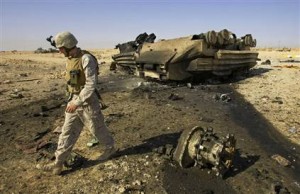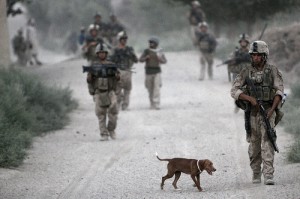U.S. Marines Find Iraq Tactics Don’t Work in Afghanistan
BY Herschel SmithBefore The Captain’s Journal is a strategy blog, we are first and foremost a logistics and tactical blog (logistics and tactics, techniques and procedures – TTP – is our first interest). We are also a Marine blog, and so naturally, when McClatchy published their article (U.S. Marines find Iraq Tactics don’t work in Afghanistan), we were interested. Several money quotes are given below, followed by commentary and analysis.
DELARAM, Afghanistan — On a sunset patrol here in late December, U.S. Marines spotted a Taliban unit trying to steal Afghan police vehicles at a checkpoint. In a flash, the Marines turned to pursue, driving off the main road and toward the gunfire coming from the mountain a half mile away.
But their six-ton vehicles were no match for the Taliban pickups. The mine-resistant vehicles and heavily armored Humvees bucked and swerved as drivers tried to maneuver them across fields that the Taliban vehicles raced across. The Afghan police trailed behind in unarmored pick-up trucks, impatient about their allies’ weighty pace.
The Marines, weighted down with 60 pounds of body armor each, struggled to climb up Saradaka Mountain. Once at the top, it was clear to everyone that the Taliban would get away. Second Lt. Phil Gilreath, 23, of Kingwood, La., called off the mission.
“It would be a ghost chase, and we would run the risk of the vehicles breaking down again,” Gilreath said. The Marines spent the next hour trying to find their way back to the paved road.
The men of the 3rd Batallion, 8th Marine Regiment, based at Camp Lejeune, are discovering in their first two months in Afghanistan that the tactics they learned in nearly six years of combat in Iraq are of little value here — and may even inhibit their ability to fight their Taliban foes.
Their MRAP mine-resistant vehicles, which cost $1 million each, were specially developed to combat the terrible effects of roadside bombs, the single biggest killer of Americans in Iraq. But Iraq is a country of highways and paved roads, and the heavily armored vehicles are cumbersome on Afghanistan’s unpaved roads and rough terrain where roadside bombs are much less of a threat.
Body armor is critical to warding off snipers in Iraq, where Sunni Muslim insurgents once made video of American soldiers falling to well-placed sniper shots a staple of recruiting efforts. But the added weight makes Marines awkward and slow when they have to dismount to chase after Taliban gunmen in Afghanistan’s rough terrain.
Even the Humvees, finally carrying heavy armor after years of complaints that they did little to mitigate the impact of roadside explosives in Iraq, are proving a liability. Marines say the heavy armor added for protection in Iraq is too rough on the vehicles’ transmissions in Afghanistan’s much hillier terrain, and the vehicles frequently break down — so often in fact that before every patrol Marine units here designate one Humvee as the tow vehicle.
The Marines have found other differences:
In Iraq, American forces could win over remote farmlands by swaying urban centers. In Afghanistan, there’s little connection between the farmlands and the mudhut villages that pass for towns.
In Iraq, armored vehicles could travel on both the roads and the desert. Here, the paved roads are mostly for outsiders – travelers, truckers and foreign troops; to reach the populace, American forces must find unmapped caravan routes that run through treacherous terrain, routes not designed for their modern military vehicles.
In Iraq, a half-hour firefight was considered a long engagement; here, Marines have fought battles that have lasted as long as eight hours against an enemy whose attacking forces have grown from platoon-size to company-size.
U.S. military leaders recognize that they need to make adjustments. During a Christmas Eve visit here, Marine Commandant Gen. James T. Conway told the troops that the Defense Department is studying how to reconfigure the bottom of its MRAPs to handle Afghanistan’s rougher terrain. And Col. Duffy White, the commander of the Special Purpose Marine Air-Ground Task Force, said he anticipates that Marines will be wearing less armor by spring, when fighting season begins again.
Commentary & Analysis
As regular readers know from our body armor coverage and analysis, we have been preaching the virtues of weight reduction in body armor for months, and even years (focusing on the weight of SAPI plates). Further, the Marine Corps was lethargic to react to known problems with troop transport, abandoning an urgent request for MRAPs in 2005. The Marines had chosen to run Amphibious Assault Vehicles across desert terrain, and one particularly brutal example of the consequences of this choice was the loss of fourteen Marines near Haditha in August 2005.
Marine Commandant Conway has lamented the heaviness of the force now, and if there is a need for lighter, faster-moving all-terrain vehicles, then the Corps cannot be as slow to react as it was in Anbar. We have also commented that some TTPs (such as satellite patrols) won’t have the same value in the rural terrain of Afghanistan versus the urban terrain of Iraq. Having said that, the lectures of the Marines will stop and the analysis will start.
First of all, the Marines do not carry “60 pounds of body armor each.” Someone has misled the journalist, or the journalist has simply gotten the wrong data, and unfortunately the misinformation has made it’s way into print.
The Modular Tactical Vest, the outer tactical vest in lieu of what the Army uses (Interceptor Body Armor vest) carries the same front, rear and side SAPI plates as the Army, and although the Marine MTV consists of slightly more soft panel protection than the IBA which adds a couple of pounds, the weight of all body armor fielded for the Army and Marines equals roughly 32 pounds, give or take a few ounces.
The balance of the weight to which the journalist refers is a hydration system, ammunition, weapon (which is hooked to the vest by a carabiner) and other odds and ends (e.g., ballistic glasses, gloves, tools, etc.). These things would be carried by the Marine whether there was body armor or not. So roughly half of the weight is non-negotiable. Further, a backpack adds much more weight to the system.
Second, the McClatchy reporter says the following: “The Afghan police trailed behind in unarmored pick-up trucks, impatient about their allies’ weighty pace,” as if the U.S. Marines were holding up the Afghan police. This is embarrassing for McClatchy, even if they aren’t embarrassed. The notion of the Afghan police being anything but rife with corruption is absurd, and there was a reason that the police didn’t go out ahead of the Marines. It’s the same reason that of the nine dead and twenty seven wounded in the Battle of Wanat, not a single one was Afghan Army. They were all U.S. Army. There wasn’t a chance in hell that the police would have gone it alone without the Marines, and they likely wouldn’t have even contributed to the fight.
Third, this example shows the need to adapt, and adapt the Marines will. But Marines who have to chase the Taliban through the hills need more Marines. Counterinsurgency will require more force projection, this being done in the rural rather than urban areas (the McClatchy article does have this right). Intelligence-driven raids and kinetic operations will ensue upon adequate contact with the population, with the Marines providing them the security they need from the Taliban.
The real fight will start when the Marines are waiting for the Taliban in their mountain lairs because of what the people have told them. Or, when the Taliban can’t come out of their caves because the Marines own the terrain. Dismounted patrols will suffice just fine with enough Marines, and the question of all-terrain vehicles won’t be such a weighty issue.
Corporal William Ash, a squad leader from 1st Platoon, Bravo Company, Battalion Landing Team 1st Battalion, 6th Marine Regiment, 24th Marine Expeditionary Unit, NATO International Security Assistance Force (ISAF), along with a stray dog lead a patrol through a city in Helmand Province, Afghanistan. When the platoon moved into the area, they found two stray dogs, and each time the Marines head out on patrol the dogs are right at the Marines’ side.
The Marines will ramp up force projection in Afghanistan, and McClatchy reports like the one above won’t take on the importance they do with minimal forces. The Marines will adapt, improvise and overcome. McClatchy, on the other hand, should do a much better job of understanding Tactics, Techniques and Procedures. And in order to have any respectability whatsoever, they need to get the data right concerning simple things like body armor weight.







Trackbacks & Pingbacks
Comments
RSS feed for comments on this post. TrackBack URL
Leave a comment